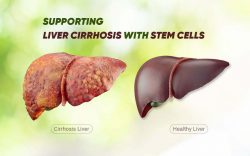Stem Cell Therapy For Liver Cirrhosis
To cure liver cirrhosis with stem cell therapy, healthy stem cells will be cultured in vitro and transplanted into the patient’s body via intravenous infusion. As an emerging therapeutic method, stem cell therapy has brought new hope to patients with liver cirrhosis. In recent years, SQ1 medical center has accumulated rich experience in stem cell therapy for liver cirrhosis.
The Beneficial Effects Of Stem Cell Therapy On Liver Cirrhosis
Stem cell therapy can enhance the ability of the human body to repair damaged liver cells and tissue. Stem cells can induce differentiation of liver cells under certain conditions, and participate in the reconstruction of liver tissue, thus effectively improving the patient’s condition as well as promoting the recovery of liver function.
The following effects can be achieved by using stem cell therapy on liver cirrhosis:
Regeneration of liver tissue
Relieved or eliminate symptoms such as loss of appetite, fatigue, ascites, and pain
Key biomarkers of liver function return to normal level
Improvement in liver fibrosis
Reduced chronic fatigue
Removal of jaundice
No more itchy skin
Improved metabolism
Immune system back to normal status
Liver Cirrhosis And Complications That Stem Cell Therapy Can Treat
Liver cirrhosis will be accompanied by complications in many patients. Stem cell therapy can treat liver cirrhosis and have a good effect on preventing or improving the complication conditions of liver cirrhosis. These complications include:
Portal vein hypertension
Portal pulmonary hypertension
Ascites
Poor absorption of fats and vitamins
Irregular bleeding
Increased risk of infections
Kidney failure
Deterioration of brain function
Liver cancer
Many experts in the world have conducted clinical trials on stem cell transplantation in humans for the treatment of decompensated cirrhosis. After transplantation, the symptoms of patients have been significantly improved, the liver function has been restored to a certain extent, and no obvious adverse reactions have been found. Stem cell therapy has become the most sensible choice for patients with liver cirrhosis!
Learn More About Liver Cirrhosis
Liver cirrhosis is a chronic progressive liver disease caused by various factors. It manifests as hyperplasia of diffused collagen fibrous tissue, which forms pseudo lobules thus destroying the normal structure of the liver. Liver dysfunction and portal hypertension are its main clinical symptoms. Patients often suffer from complications such as loss of appetite, lethargy, and jaundice due to decreased liver function. In the late stage, upper gastrointestinal bleeding, secondary infection, ascites, and cancer often occur, resulting in a major decline in life quality and affecting the long-term survival rate of the patients.
Hepatitis is a major cause of liver cirrhosis, According to the “2017 Global hepatitis Report” released by the World Health Organization in Geneva, as of 2017, there were about 325 million people infected with chronic hepatitis B or hepatitis C virus in the world, nearly 120 million people suffer from cirrhosis, along with millions of deaths. Liver cirrhosis has become the fifth leading cause of death in the world. The incidence of liver disease is still increasing year by year.
Risk Factors For Cirrhosis
Liver cirrhosis develops from a variety of chronic liver diseases, any adverse factors that affect the normal function of the liver can be considered risk factors for liver cirrhosis. It is important to understand the causes of cirrhosis so that the symptoms can be treated and prevent the disease from been worsen.
Most common risk factors include:
Alcoholism
Non-alcoholic fatty liver disease
Viral hepatitis
Bile duct obstruction
Adverse drug reaction or poisoning
Autoimmune liver disease
Genetic and metabolic diseases
Long-term cholestasis
Liver blood circulation disorder
Parasitic infection
Clinical Symptoms Of Liver Cirrhosis
There are various manifestations of liver cirrhosis. There are about 10-to 20% of patients with early liver cirrhosis are asymptomatic, or only have digestive system symptoms such as fatigue, loss of appetite, and diarrhea.
When patients begin to experience more severe symptoms, including:
Feeling tired and unwell
No feeling of hunger and weight loss
Jaundice (yellow stain of skin and eye whites)
Small dots or large patches of red-purple rash
Itching all over the body
If cirrhosis is caused by alcohol or long-term liver disease, you may also experience the following symptoms:
Muscle wasting
Liver palm
Abdominal swollen (due to excessive fluid)
Small bright red spots on skin surrounded by microvascular that look like spider legs (spider moles)
Swollen salivary glands – glands that secrete saliva
Enlarged breasts, testicular atrophy, sparse armpit hair(male)
Advantages Of Stem Cell Therapy On Liver Cirrhosis
Currently, there is no effective treatment for cirrhosis and the liver damage is permanent.
Your doctor may offer some ways to relieve the symptoms of cirrhosis and complications according to your symptoms, such as medication or venous shunts to lower venous pressure. But these methods could only relieve the symptoms rather than cure the disease. In the event of liver failure, liver transplantation is still the most effective treatment, but its usage is limited by the high cost, limited donors, and immune rejection after transplantation.
Stem cell therapy
Conventional treatment
Curative Treatment or diseases management
Stem cell therapy is a new treatment for liver cirrhosis, which differentiate stem cells into liver cells, thus repairing or regenerating liver tissue and restoring liver function. It is a treatment that can cure liver cirrhosis. If treated with stem cells at an early stage, damage to liver tissue can be reversed and prevent future liver damage or development of complications.
Conventional therapy can only prevent liver cirrhosis from getting worse through disease management such as lifestyle adjustments, for example, stopping drinking alcohol, and not taking drugs without a doctor’s permit. The doctors may take minor interventions, i.e., prescribe medications or minor surgery to treat complications, but those treatments can not cure cirrhosis.
Side-effects
No side effects, because the stem cells come from the body itself, their immunogenicity is extremely low, stem cells are produced under very strict quality control, and there are guaranteed no side effects.
Patients with cirrhosis should stop taking medications.
If you take medicine for hepatitis, it may have some side effects on the gastrointestinal tract, such as nausea and vomiting.
Convenience
Stem cell therapy is performed by stem cell experts and requires specialized laboratories to process stem cells and medical equipment to extract and inject stem cells, After the treatment, the patient does not need to receive repeated or frequent treatment, patients can return to a high-quality life.
If a patient with liver cirrhosis has serious complications such as varicose veins, the doctor may use venous shunt surgery to temporarily relieve symptoms. Patients need to go to the hospital frequently, which is a great inconvenience.
Longevity
If treated at an early stage, stem cell therapy can improve symptoms of liver cirrhosis and prevent complications, and rebuild liver function, thus restoring a healthy life in the long run.
If treated at a late stage, symptoms of cirrhosis and complications can be alleviated, and liver transplantation can even be avoided.
Conventional disease management methods such as adjusting diet can only delay the future deterioration of liver cirrhosis, but not help with the treatment of liver cirrhosis.
End-stage
Stem cells are a fundamental part of our body, and the main function of stem cells is to regenerate damaged cells and replicate their cells to repair or regenerate liver tissue, allowing patients to delay or avoid liver transplantation.
Liver transplantation is the only treatment option for end-stage patients. The high risk of surgical treatment, limited donors, rejection reaction, and other serious surgical complications are major concerns.
How Can Stem Cells Therapy For Liver Cirrhosis Work
Stem cell therapy is a method that injects healthy stem cells into patients through intravenous infusion. The stem cells in patients’ bodies with self-replication and multi-directional differentiation potential will help to repair damaged liver cells and restore liver function. Stem cells work through the following four mechanisms:
Self-differentiation: Stem cells can differentiate into hepatic parenchymal cells in endoderm, stem cells can also directly differentiate into endoderm hepatic parenchymal cells, thus replacing damaged liver cells and regenerating healthy liver tissue to restore liver function, and it’s free from immune rejection reactions after transplantation.
Immunomodulatory effect: Stem cells can also secrete soluble cytokines to mediate immune suppression, induce immune tolerance, inhibit the proliferation and migration of immune cells to the liver, reduce immune inflammation in the damaged liver, and increase the survival rate of patients with liver disease.
Paracrine effect: The paracrine effect of stem cells is also one important mechanism for promoting liver regeneration and liver damage reduction. Stem cells can produce various cytokines, chemokines, growth factors, and exosomes to help with liver tissue repair indirectly or remotely.
Stem cell transplantation can reduce the deposition of collagen in liver tissue: Stem cells also inhibit the expression of transforming growth factor- β1(TGF β1) and smooth muscle actin in liver cells and reduce the severity of liver fibrosis.
SQ1 Stem Cell Services
During the whole treatment process, we’ll provide complete and first-class medical services to you. And to ensure your treatment effect, you can consult your doctor any time after the treatment.

















